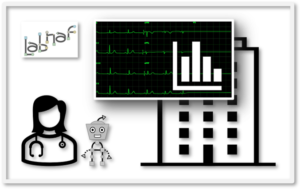The goal of this article is to explain, using some simple medical analogy, what the process of driving enterprise transformations is. This is not, by any means, a proposed approach for healthcare, as this would require some sound medical expertise.
How does the process of driving enterprise transformations would translate into a holistic process of driving people health?
Any process can be performed by performers, that is a combination of humans, equipment and software. So, in the present case, the performers would be medical staff, medical equipment and medical software.
Let’s call this people + equipment + software combination the “augmented doctor”.

- As a prerequisite, the augmented doctor learns about the human as a whole, its functions and the supporting organs, how they interact with each other. How these functions (e.g. breathing, blood oxygenation, blood pumping, blood distribution etc.) are used by high-level processes/value streams (e.g. organs’ oxygenation) and how these processes bring value (e.g. fitness, well-being, life).
- For each patient, and as a recurrent process, the augmented doctor collects and integrates data about the individual. There are recurrent measurements of all kinds, information about past incidents etc.
![]()
- This information is digitalized and summarized using heat maps.
![]()
- The augmented doctor makes some context analysis and diagnosis, taking into account the internal measurements (blood pressure…) and the external context (COVID …).
- This is then summarized using SWOTs.
![]()
- Then the augmented doctor starts reviewing the process(es) and identifies what underlying functions and related organs needs to be treated.
- The augmented doctor defines some SMART goals for what needs to be achieved.
![]()
- Before any planning, the augmented doctor reviews some medical principles and standards.
- To realize the goals, the augmented doctor defines some target capabilities i.e. some target level of functionality. The doctor also defines how these different target capabilities depend on each other and what their priorities are.
- Based on the priorities and dependencies, a target capabilities roadmap is created.
![]()
- The delivery of these target capabilities (of these functional improvements) is then scheduled in the form of project roadmaps. So, a set of treatments is now scheduled. But we don’t know yet what they will be precisely made of.
![]()
- Each starting project focuses on specific functional improvements. A concrete solution is defined. It could be medication, surgery, exercises, physiotherapy etc. Resources of many different nature are selected (surgeon, nurse, pills, training bike…) and tasks (surgery, fitness, periodical controls…). The TO-BE situation is described.
- The treatment can have a fix scope with an end date, for example in the case of a broken leg. Or the treatment can have a variable scope without end date be because there are some trials and discoveries until the working solutions is appropriate, for example for allergies.
- If the patient accepts the solution, then the implementation of the treatment starts. The augmented doctor governs that implementation.

- The augmented doctor integrates all new information about the patient, so that the AS-IS and TO-BE situations are up to date.
![]()
Read more about the Labnaf process of driving transformations (or you can instead watch this video)



